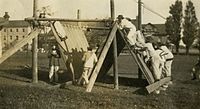
The Royal Military College of Canada, abbreviated in English as RMC and in French as CMR, is a military academy and, since 1959, a degree-granting university of the Canadian Armed Forces. It was established in 1874 and conducted its first classes on June 1, 1876. The Government of Ontario empowered RMC to confer degrees in the Social Sciences and Humanities, Science, and Engineering through The Royal Military College of Canada Degrees Act, 1959. Programs are offered at the undergraduate and graduate levels, both on campus as well as through the college's distance learning program via the Division of Continuing Studies.
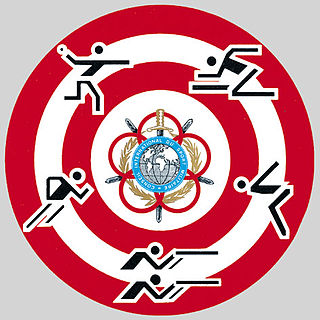
The Military Pentathlon is a multisport. It resembles the modern pentathlon but updated to skills used by the modern military.

The standing long jump, also known as the standing broad jump, is an athletics event. It was an Olympic event until 1912. It is one of three standing variants of track and field jumping events, which also include the standing high jump and standing triple jump.

The RMC Paladins are the athletic teams that represent Royal Military College of Canada in Kingston, Ontario, Canada. Its facilities include the Kingston Military Community Sport Centre (KMCSC) with seating for 3737, the Navy Bay fields with seating for 800 and Constantine Arena with seating for 1500 and the Birchall Pavilion.
An assault course is a trail that combines running and exercising. It was more popular in the 1970s than it is now. It is often used in military training. The prime use is to evaluate progress and weaknesses of the individual or the team involved. The term Assault Course can be replaced by Obstacle Course, which some view as more accurate. Confidence Courses is another term used. There are also specific Urban Obstacle Courses and Night Obstacles Courses. An Obstacle Course Race (OCR) is a civilian sporting and fitness challenge event which combines obstacles and cross country running.

A ropes course is a challenging outdoor personal development and team building activity which usually consists of high elements, low elements, or some combination of the two. Low elements take place on the ground or above the ground. High elements are usually constructed in trees or made of utility poles and require a belay for safety.

The All Arms Commando Course (AACC) lasts for 13 weeks and is run by the Royal Marines at the Commando Training Centre Royal Marines (CTCRM), Lympstone. Members from any of the United Kingdom's Regular Armed Forces and overseas exchange personnel can attend to serve with 3 Commando Brigade. On completion of the course the successful candidate earns the right to wear the green beret, and to wear the "Commando Dagger" on their uniform. The Royal Marines expect that nearly half of the volunteers will drop out or be dismissed before completing the AACC. The primary aim of the course is to give service personnel the core military skills necessary for Extremely and Very High readiness Commando and Littoral Strike operations.
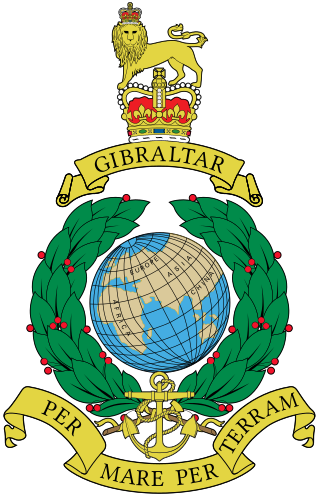
The Royal Marines Reserve (RMR) is the volunteer reserve force used to augment the regular Royal Marines. The RMR consists of some 600 trained ranks distributed among the four units within the UK. About 10 percent of the force are working with the Regular Corps on long-term attachments in all of the Royal Marines regular units. All the volunteers within the RMR must pass through the same rigorous commando course as the regulars. The former may be civilians with no previous military experience or may be former regular Royal Marines.
The Potential Royal Marines Course, often abbreviated to PRMC, was a Royal Marines selection course for Potential Recruits. The course was held at the Commando Training Centre Royal Marines, and was designed to assess a candidate's suitability for entry into the Royal Marines. The course in no longer held having been replaced by the Candidate Preparation Course (CPC).

The Sandhurst Military Skills Competition is a military skills competition at West Point that first began in 1967 with the presentation of a British officer's sword to the United States Corps of Cadets by the British Exchange Officer. 2010's event, dubbed SANCOM10, was a two-day event conducted at West Point, New York. The 2009 competition featured a record 49 teams and nearly 500 competitors. Besides the 36 squads from each of the West Point companies, visiting service academy teams included the Naval, Air Force and Coast Guard Academies, Britain's Royal Military Academy Sandhurst (RMAS) teams "Red" and "Blue", Australia's Royal Military College Duntroon, Canada's Royal Military College (RMC), the National Military Academy of Afghanistan, and the Chilean Military School. That year saw eight ROTC squads: Texas A&M, BYU, East Carolina University, Iowa State University, Florida Tech, Georgetown, University of Hawaii, and Appalachian State.
The Potential Regiment Officers Course (PROC) is an assessment tool of the Royal Air Force (RAF) in the United Kingdom, for people wishing to become an Officer in the Royal Air Force Regiment. Currently the candidates, who as of September 2017 can be male or female, will already have passed the Officer and Aircrew Selection Centre. It has been in existence since April 2008, where it was previously known as the Potential Regiment Officers Acquaintance Course (PROAC). This name was changed due to confusion over whether the course was assessed or merely an introduction to the RAF Regiment.
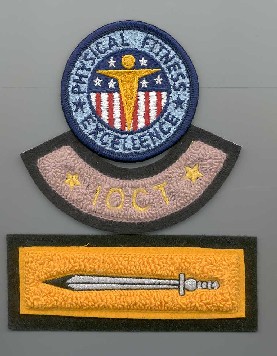
The Indoor Obstacle Course Test (IOCT) is a test of full-body functional physical fitness administered by the Department of Physical Education (DPE) at the United States Military Academy at West Point, New York. DPE considers the IOCT to be one of the best evaluations of total body fitness given in the Army. Cadets who earn an A− are authorized to wear the IOCT Badge on their athletic shorts.

The Department of Physical Education is the academic department that oversees the physical development program at the United States Military Academy at West Point, New York. DPE is headquartered in the Arvin Cadet Physical Development Center. DPE has 24 Military faculty and 25 civilian instructors and professors. The head of the department holds the ceremonial title of Master of the Sword, known within the department as the MOS. This title dates back to when the Cadets at West Point were taught swordsmanship as part of their military and physical training. The current Master of the Sword is COL Nicholas Gist, who has held the position since 2015. The department's stated mission is:
The Department of Physical Education develops warrior leaders of character who are physically and mentally tough by engaging cadets in activities that promote and enhance a healthy lifestyle, physical fitness, movement behavior, and psychomotor performance.

United States Air Force Basic Military Training is a seven-week program of physical and combat training required in order for an individual to become enlisted into the United States Air Force, Air Force Reserve, Air National Guard and United States Space Force. It is located at Lackland Air Force Base in San Antonio, Texas.

Spartan Race is a series of obstacle races of varying difficulty, ranging from 3 miles to ultra-marathon distances of 50k+.
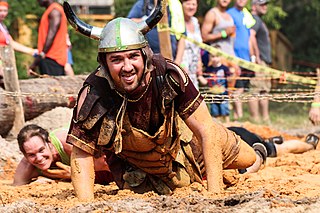
Obstacle course racing (OCR) is a sport in which a competitor, traveling on foot, must overcome various physical challenges in the form of obstacles. Races vary in length from courses with obstacles close together to events of several kilometers which incorporate elements of track, road and/or cross country/trail running. Courses may include climbing over walls or up ropes, monkey bars, carrying heavy objects, traversing bodies of water or mud, crawling under barbed wire, and jumping through fire. Since the beginning of modern OCR in 1987, the sport has grown in popularity such that more than 2500 events are held annually across the world and several run organizing companies are commercially successful.

Ninja Warrior UK is a British physical obstacle assault course game show, created for ITV. The show is based upon the format of the Japanese game show Sasuke, created by Ushio Higuchi, which is aired in the United Kingdom and other countries as Ninja Warrior.
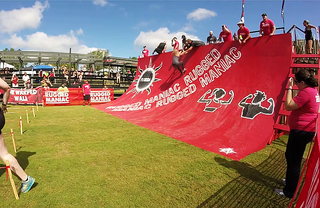
The warped wall is an obstacle on many obstacle courses for obstacle racing.
Series Two of Ninja Warrior UK, a British physical obstacle assault course game show, was aired on ITV during 2016, from 2 January to 13 February. Prior to the final episode of the previous series, the broadcaster decided it would renew the show for a second series, making the announcement on 29 May 2015. Of the 250 contestants, this series' competition was won by Owen McKenzie. During its broadcast, the series averaged around 3.53 million viewers.
Series Three of Ninja Warrior UK, a British physical obstacle assault course game show, was aired on ITV from 31 December 2016 to 18 February 2017. Of the 250 contestant who took part, this series' competition was won by Jonny Urszuly. During its broadcast, the series averaged around 3.81 million viewers.


